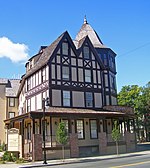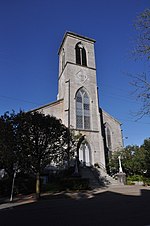Catskill Mountain Railroad
1982 establishments in New York (state)CatskillsHeritage railroads in New York (state)Kingston, New YorkRailway companies established in 1982 ... and 2 more
Tourist attractions in Ulster County, New YorkTransportation in Ulster County, New York
The Catskill Mountain Railroad (reporting mark CMRR) is a heritage tourist railroad based in Kingston, New York, that began operations in 1982. The railroad leases a 4.7-mile portion (MP 3.6 to MP 8.3) of the former New York Central Railroad Catskill Mountain branch from Kingston to Stony Hollow, New York. The tracks are owned by Ulster County, New York, which bought them in 1979 from the bankruptcy estate of the Penn Central Railroad. The railroad's current permit with Ulster County expires on December 31, 2028.
Excerpt from the Wikipedia article Catskill Mountain Railroad (License: CC BY-SA 3.0, Authors).Catskill Mountain Railroad
Plaza Road,
Geographical coordinates (GPS) Address Nearby Places Show on map
Geographical coordinates (GPS)
| Latitude | Longitude |
|---|---|
| N 41.935354 ° | E -74.015094 ° |
Address
Plaza Road
12401
New York, United States
Open on Google Maps









